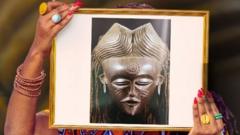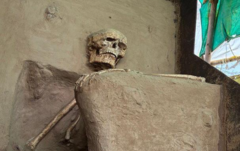Rohit Bal, a pioneering presence in the Indian fashion industry, has passed away at the age of 63 following an extended battle with illness.
Rohit Bal: A Trailblazer in Indian Fashion Dies Aged 63

Rohit Bal: A Trailblazer in Indian Fashion Dies Aged 63
Celebrated designer reshaped Indian fashion with innovative designs and deep textile knowledge.
Bal, famed for his rich understanding of Indian textiles and meticulous designs, was recognized by the Fashion Design Council of India (FDCI) as having "redefined Indian fashion." His career, which began in the 1990s, helped establish fashion designing as a respected and lucrative profession, inspiring a new generation of Indian designers.
Making a notable return to the fashion scene mere weeks before his death, Bal appeared visibly frail but enthusiastic during the grand finale of the India Fashion Week. His designs, celebrated for a unique blend of Indian heritage and contemporary style, graced the bodies of Hollywood A-listers and supermodels alike.
Born in 1961 in Srinagar, Kashmir, Bal's artistic journey started after earning his history degree from St. Stephen's College in Delhi and subsequently studying fashion design at the National Institute of Fashion Technology (NIFT). By 1990, he launched his own label, quickly gaining acclaim for his lavish use of materials like velvet and brocade, often incorporating motifs inspired by India’s nature and culture, notably lotus and peacock patterns.
As a testament to his talent, Time magazine dubbed him India's 'Master of fabric and fantasy' in 1996. In addition to his clothing label, Bal ventured into various industries, endorsing products ranging from footwear to luxury watches. He notably designed costumes for the Indian adaptation of the international hit game show “Kaun Banega Crorepati” and created exclusive collections for online retailers.
Despite his flamboyant personality often portrayed in the media, Bal emphasized the profound connection between fabric and design, stating, "Fabric is the seed of designing a garment, it is the lifeblood of fashion." His studio was a manifestation of this belief, filled with the vibrant shades and textures he loved.
Bal’s childhood in Kashmir had a lasting impact on his aesthetic sensibilities. His formative experiences with textiles, starting from the warmth of a shawl to the intricate details of his mother's saris, sparked a lifelong passion. The designer also ventured into the culinary scene in Delhi with the opulent Veda restaurant and actively engaged in various creative projects.
As a cultural icon, Rohit Bal’s legacy continues to resonate, demonstrating that style can bridge generational divides through a commitment to artistic innovation and cultural depth. He will be remembered as a visionary who not only revolutionized Indian fashion but also celebrated its rich tapestry in a global context.
Making a notable return to the fashion scene mere weeks before his death, Bal appeared visibly frail but enthusiastic during the grand finale of the India Fashion Week. His designs, celebrated for a unique blend of Indian heritage and contemporary style, graced the bodies of Hollywood A-listers and supermodels alike.
Born in 1961 in Srinagar, Kashmir, Bal's artistic journey started after earning his history degree from St. Stephen's College in Delhi and subsequently studying fashion design at the National Institute of Fashion Technology (NIFT). By 1990, he launched his own label, quickly gaining acclaim for his lavish use of materials like velvet and brocade, often incorporating motifs inspired by India’s nature and culture, notably lotus and peacock patterns.
As a testament to his talent, Time magazine dubbed him India's 'Master of fabric and fantasy' in 1996. In addition to his clothing label, Bal ventured into various industries, endorsing products ranging from footwear to luxury watches. He notably designed costumes for the Indian adaptation of the international hit game show “Kaun Banega Crorepati” and created exclusive collections for online retailers.
Despite his flamboyant personality often portrayed in the media, Bal emphasized the profound connection between fabric and design, stating, "Fabric is the seed of designing a garment, it is the lifeblood of fashion." His studio was a manifestation of this belief, filled with the vibrant shades and textures he loved.
Bal’s childhood in Kashmir had a lasting impact on his aesthetic sensibilities. His formative experiences with textiles, starting from the warmth of a shawl to the intricate details of his mother's saris, sparked a lifelong passion. The designer also ventured into the culinary scene in Delhi with the opulent Veda restaurant and actively engaged in various creative projects.
As a cultural icon, Rohit Bal’s legacy continues to resonate, demonstrating that style can bridge generational divides through a commitment to artistic innovation and cultural depth. He will be remembered as a visionary who not only revolutionized Indian fashion but also celebrated its rich tapestry in a global context.





















